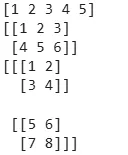ndarray is a short form for N-dimensional array which is a important component of NumPy. It’s allows us to store and manipulate large amounts of data efficiently. All elements in an ndarray must be of same type making it a homogeneous array. This structure supports multiple dimensions which makes it ideal for handling complex datasets like those used in scientific computing or data analysis. With this we can perform fast and memory efficient operations on data.
Let's understand this with a simple example:
Python
import numpy as np
arr1 = np.array([1, 2, 3, 4, 5])
arr2 = np.array([[1, 2, 3], [4, 5, 6]])
arr3 = np.array([[[1, 2], [3, 4]], [[5, 6], [7, 8]]])
print(arr1)
print(arr2)
print(arr3)
Output:
 Example
ExampleAttributes of ndarray
Understanding the attributes of an ndarray is important while working with NumPy effectively. Here are the key attributes:
- ndarray.shape: Returns a tuple representing the shape (dimensions) of the array.
- ndarray.ndim: Returns the number of dimensions (axes) of the array.
- ndarray.size: Returns the total number of elements in the array.
- ndarray.dtype: Provides the data type of the array elements.
- ndarray.itemsize: Returns the size in bytes of each element
Example:
Python
import numpy as np
arr = np.array([[1, 2, 3], [4, 5, 6]])
print("Shape:", arr.shape)
print("Dimensions:", arr.ndim)
print("Size:", arr.size)
print("Data type:", arr.dtype)
print("Item size:", arr.itemsize)
Output:
 Attributes of ndarray
Attributes of ndarrayArray Indexing and Slicing
NumPy allows indexing and slicing operations on ndarrays which offers more flexibility compared to standard Python lists. Here's a overview:
1. Basic Indexing
We can access individual elements in an array using square brackets just like Python lists. The indexing starts at 0.
Python
import numpy as np
arr = np.array([10, 20, 30, 40, 50])
print(arr[2])
Output:
30
2. Slicing
It allows us to extract sub-arrays using a range of indices. The syntax is [start:stop] where start is inclusive and stop is exclusive.
Python
import numpy as np
arr = np.array([10, 20, 30, 40, 50])
print(arr[1:4])
Output:
[20 30 40]
3. Multi-dimensional Indexing
We can index and slice each dimension separately in multi-dimensional arrays. This allows us to access specific rows, columns or deeper dimensions of the array.
Python
import numpy as np
arr_2d = np.array([[1, 2, 3], [4, 5, 6], [7, 8, 9]])
print(arr_2d[1, 2])
print(arr_2d[0:2, 1:3])
Output:
 Multi-dimensional Indexing
Multi-dimensional IndexingArray Operations
NumPy allows us to perform operations on entire arrays which enables efficient computation without the need for explicit loops. These operations include:
1. Element-wise Operations
These are straightforward and allow us to perform arithmetic operations on each element of the array directly.
Python
import numpy as np
arr = np.array([1, 2, 3])
arr2 = np.array([4, 5, 6])
print(arr + arr2)
print(arr * arr2)
print(arr - arr2)
print(arr / arr2)
Output:
 Element-wise Operations
Element-wise Operations2. Matrix Operations (Dot product)
It allow us to multiply two arrays or matrices and get a single value or another matrix.
Python
import numpy as np
matrix1 = np.array([[1, 2], [3, 4]])
matrix2 = np.array([[5, 6], [7, 8]])
print(np.dot(matrix1, matrix2))
Output:
 Dot product
Dot product3. Broadcasting
This feature enables us to perform operations on arrays of different shapes. NumPy automatically adjusts the smaller array to match the shape of the larger one for the operation.
Python
import numpy as np
arr = np.array([[1, 2], [3, 4]])
print(arr + 10)
Output:
 Broadcasting
Broadcasting4. Reshaping and Flattening
NumPy provides functions to reshape or flatten arrays which is useful when working with machine learning or deep learning algorithms.
- Reshaping: Change the shape of an array while keeping the data same.
Python
import numpy as np
arr = np.array([1, 2, 3, 4, 5, 6])
reshaped_arr = arr.reshape(2, 3)
print(reshaped_arr)
Output:
 Reshaping
Reshaping- Flattening: Convert multi-dimensional arrays into one-dimensional arrays.
Python
import numpy as np
arr = np.array([[1, 2, 3], [4, 5, 6]])
flattened_arr = arr.flatten()
print(flattened_arr)
Output:
[1 2 3 4 5 6]
NumPy provides the tools needed to efficiently handle and manipulate large datasets making it an important library for numerical tasks in Python.
